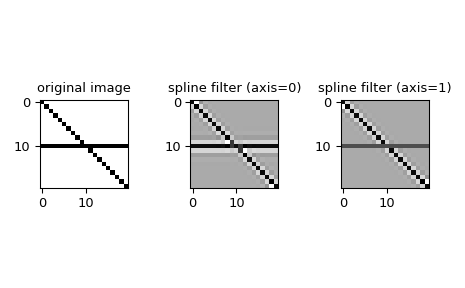scipy.ndimage.spline_filter1d¶
-
scipy.ndimage.spline_filter1d(input, order=3, axis=-1, output=<class 'numpy.float64'>, mode='mirror')[source]¶ Calculate a 1-D spline filter along the given axis.
The lines of the array along the given axis are filtered by a spline filter. The order of the spline must be >= 2 and <= 5.
- Parameters
- inputarray_like
The input array.
- orderint, optional
The order of the spline, default is 3.
- axisint, optional
The axis along which the spline filter is applied. Default is the last axis.
- outputndarray or dtype, optional
The array in which to place the output, or the dtype of the returned array. Default is
numpy.float64.- mode{‘reflect’, ‘constant’, ‘nearest’, ‘mirror’, ‘wrap’}, optional
The mode parameter determines how the input array is extended beyond its boundaries. Default is ‘constant’. Behavior for each valid value is as follows:
- ‘reflect’ (d c b a | a b c d | d c b a)
The input is extended by reflecting about the edge of the last pixel.
- ‘constant’ (k k k k | a b c d | k k k k)
The input is extended by filling all values beyond the edge with the same constant value, defined by the cval parameter.
- ‘nearest’ (a a a a | a b c d | d d d d)
The input is extended by replicating the last pixel.
- ‘mirror’ (d c b | a b c d | c b a)
The input is extended by reflecting about the center of the last pixel.
- ‘wrap’ (a b c d | a b c d | a b c d)
The input is extended by wrapping around to the opposite edge.
- Returns
- spline_filter1dndarray
The filtered input.
See also
spline_filterMultidimensional spline filter.
Notes
All functions in ndimage.interpolation do spline interpolation of the input image. If using B-splines of order > 1, the input image values have to be converted to B-spline coefficients first, which is done by applying this 1-D filter sequentially along all axes of the input. All functions that require B-spline coefficients will automatically filter their inputs, a behavior controllable with the prefilter keyword argument. For functions that accept a mode parameter, the result will only be correct if it matches the mode used when filtering.
Examples
We can filter an image using 1-D spline along the given axis:
>>> from scipy.ndimage import spline_filter1d >>> import matplotlib.pyplot as plt >>> orig_img = np.eye(20) # create an image >>> orig_img[10, :] = 1.0 >>> sp_filter_axis_0 = spline_filter1d(orig_img, axis=0) >>> sp_filter_axis_1 = spline_filter1d(orig_img, axis=1) >>> f, ax = plt.subplots(1, 3, sharex=True) >>> for ind, data in enumerate([[orig_img, "original image"], ... [sp_filter_axis_0, "spline filter (axis=0)"], ... [sp_filter_axis_1, "spline filter (axis=1)"]]): ... ax[ind].imshow(data[0], cmap='gray_r') ... ax[ind].set_title(data[1]) >>> plt.tight_layout() >>> plt.show()

